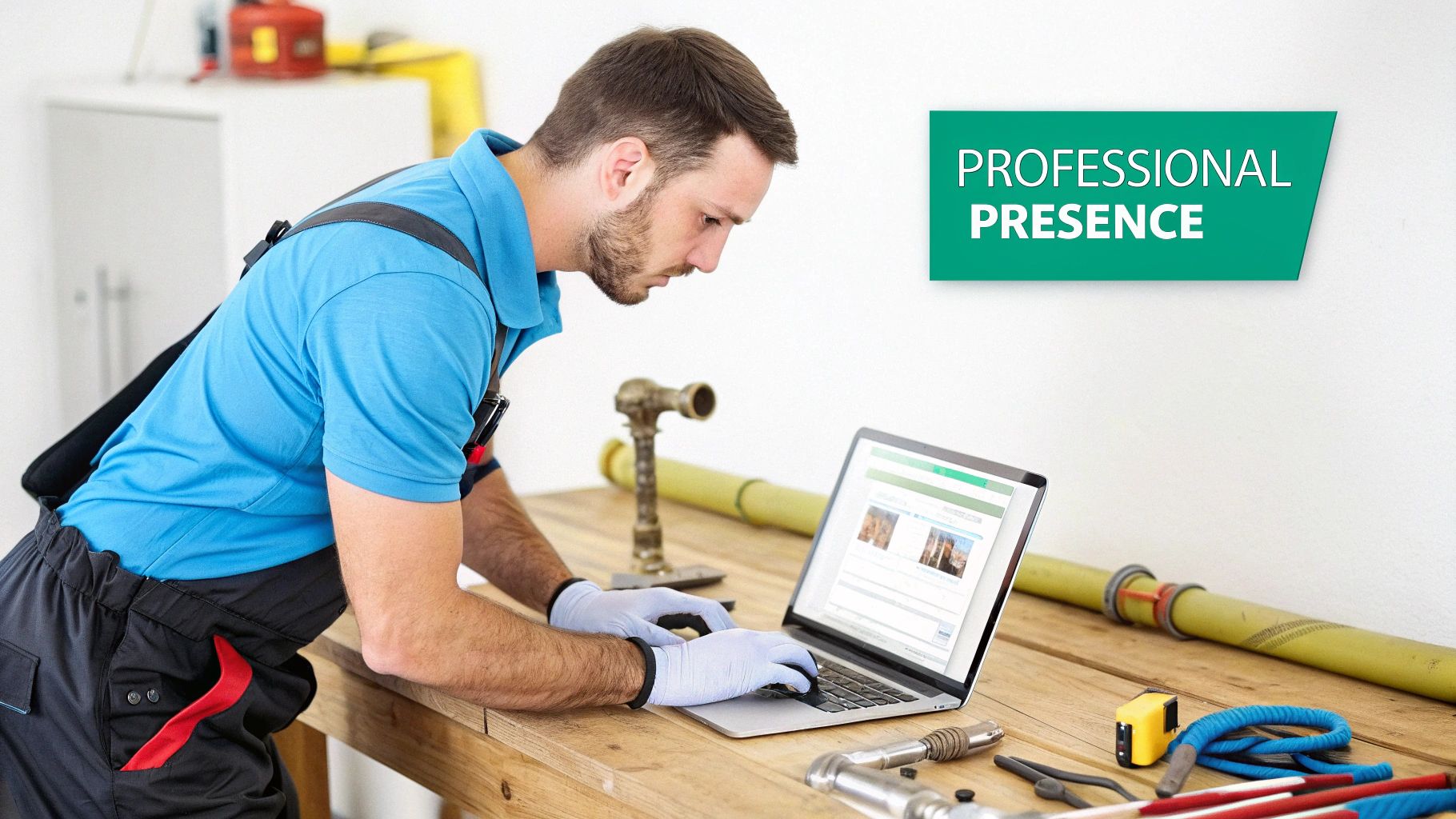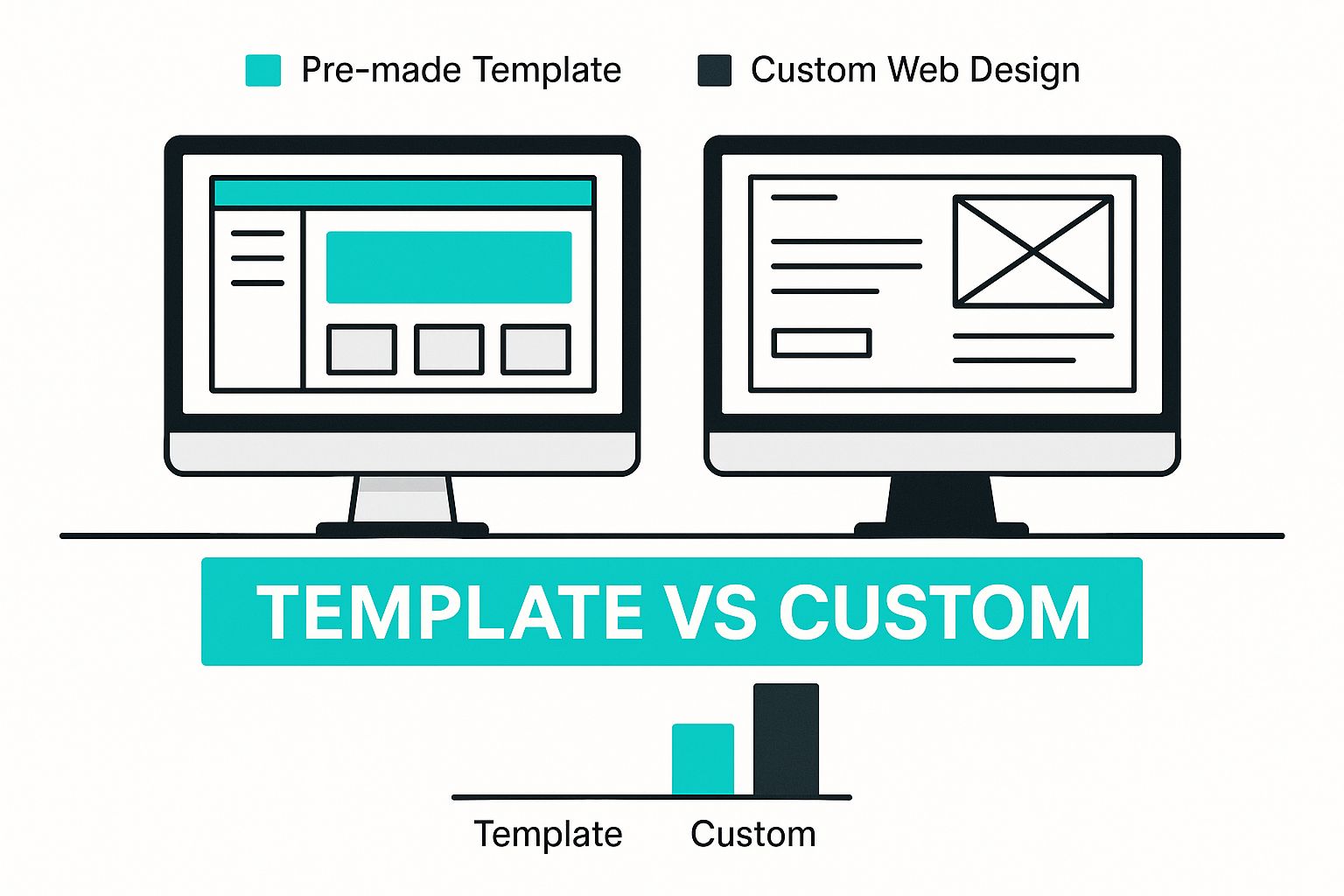Why Most Plumbers Are Missing Out on Digital Gold

Let's be honest: a lot of plumbers are still focused on the physical aspects of the job – wrenches, pipes, and drain snakes. Meanwhile, their savvier competitors are quietly building online empires. I've spoken with tons of plumbing business owners, and the ones who are truly thriving understand one key thing: their website isn't an expense; it's their hardest-working employee. It's on the clock 24/7, generating leads and boosting their brand.
This isn't just a fad; it's a complete shift in how people find services. Imagine: your toilet's overflowing at 2 AM. What's your first move? You grab your phone and search for "emergency plumber near me." If your business isn't showing up, you've already lost that customer. Plumbers who prioritize a smart web design are consistently outperforming those relying on old-school methods, often seeing 3x the results.
And this isn't just some theory I'm throwing around. I've seen firsthand how even small website tweaks can lead to huge revenue jumps. One plumbing company I worked with simply made their phone number more prominent on their mobile site and added a click-to-call button. The result? A 20% increase in emergency calls within a month. Another client focused on local SEO, optimizing their Google My Business profile and targeting location-based keywords. They saw a 35% boost in organic leads in just three months. This is the new reality for plumbers who see their website as a crucial business strategy.
Speaking of strategy, the global plumbing fixtures market – closely tied to the online success of plumbing companies – is expected to hit $115.32 billion by 2025, with a CAGR of 8% from $106.73 billion in 2024. This growth emphasizes the importance of a strong online presence for plumbers. Discover more insights about the plumbing market.
So, are you leaving potential profits untapped? Missing out on the "digital gold" just waiting to be discovered? The good news is, you don't have to be a tech genius to succeed. You just need to understand the game. This guide will give you the tools to turn your website from a digital desert into a lead-generating powerhouse.
Is Your Website Working as Hard as You Are?
So many plumbers invest in a website and then scratch their heads, wondering why it's not bringing in more business. They're putting in the hours, delivering great service, but their online presence is falling short. The issue often isn't a lack of effort; it's a disconnect between their website and how people actually search for plumbers. This is where effective web design comes in. It's about understanding online customer behavior, anticipating their needs, and making it effortless for them to find you and choose your services. Forget fancy graphics or complex code; it's about building a website that works as hard as you do.
The Hidden Reasons Your Website Isn't Getting Calls
So, you got a website for your plumbing business. Great! But is it bringing in new customers? I've looked at tons of plumbing websites, and I've seen some common problems that separate the successful ones from the ones that just… exist. Lots of plumbers fall into these traps without even knowing it – maybe they choose the wrong design, or they don't understand how their customers search online.
Why "Traditional" Web Design Fails Plumbers
Traditional web design often focuses on looking good. But for a service business like plumbing, being functional is way more important. Think about it: a potential customer has a burst pipe at 3 AM. They're panicking, searching on their phone. A website with fancy animations and a complicated menu will send them straight to your competitor who has a simpler, faster site. That's why user experience, especially on mobile, is so important for plumbers. Want to dive deeper? Check out our guide on web design best practices.
What Customers (and Search Engines) Really Want
Here's the key: your website needs to work for both customers and search engines like Google. Google likes websites that have useful, relevant info. They also care about technical stuff like site speed and if your site works well on phones (mobile-friendliness). Customers, on the other hand, want a site that’s easy to use, with clear contact info and things that make them trust you. They want to know you're a real business that can fix their plumbing problem fast. Want to make your website look even better? Consider an AI Website Images Generator.
Are You Making These Mistakes?
One huge mistake is ignoring local SEO. When someone searches for "plumber near me", local SEO decides who shows up first. Another common problem is not focusing on conversion optimization. A pretty website is pointless if it doesn't get visitors to call. Think clear calls-to-action, easy-to-find contact info, and maybe even online booking. And don't forget trust signals. Things like customer testimonials, certifications, and professional photos make you look credible and encourage people to choose you.
Speaking of getting the right help, I've noticed a lot of plumbing businesses aren't happy with their current SEO. Something like 70% of plumbers say they’re dissatisfied, often because the service isn't working or the communication is bad. Check out more stats on this. This shows how important it is to choose a web design and SEO partner who really gets plumbing businesses. Don't settle for a generic web designer – find someone who understands your industry.
Capturing Emergency Customers on Mobile Devices
Picture this: It's 2 AM, and a pipe bursts, sending water cascading through a homeowner's basement. Their first move? Grab their smartphone and frantically search for "emergency plumber near me." This is a prime customer, desperate for a solution and willing to pay for immediate service. But if your plumbing website isn't mobile-friendly, you're missing out on this valuable business. So many plumbing websites are designed like brochures, not emergency response tools. Let's fix that.
Mobile-First for Plumbing Emergencies
Consider the mindset of someone in a plumbing crisis. They're stressed, likely on a small screen, and need help now. Your website has to load instantly, feature a prominent "click-to-call" button, and clearly display your service area. Forget fancy animations or complex navigation—keep it simple. A clear, concise message like "24/7 Emergency Plumbing Services" can be incredibly effective.
To illustrate the difference between a generic template and a custom design, take a look at this:

The custom design prioritizes contact info and key services, while the template site feels cluttered and less focused on immediate needs. A streamlined mobile experience is essential for capturing these emergency customers.
Speed and Contact are King
Studies show that 70% of mobile searches for local businesses result in a visit within 24 hours. This underscores the need for a mobile-optimized, easy-to-navigate website. Learn more about these statistics. In my experience, I've seen load times under 3 seconds drastically improve conversions for emergency services. Every second counts when a homeowner is dealing with a flooded bathroom!
Let's talk a bit about how user behavior differs between mobile and desktop, which has significant implications for your website design. The following table highlights these differences:
Mobile vs Desktop User Behavior for Plumbing Services
| User Behavior | Mobile Users | Desktop Users | Design Implications |
|---|---|---|---|
| Information Needs | Immediate, problem-focused | Research-oriented, comparing options | Prioritize clear contact info and concise service descriptions on mobile. |
| Search Behavior | "Near me" searches, location-based | Broader searches, may not include location | Optimize for local SEO on mobile. |
| Conversion Goals | Click-to-call, quick contact | Form submissions, detailed inquiries | Prominent call button on mobile, easy forms on both platforms. |
| Time Sensitivity | High, urgent | Lower, more flexible | Fast loading speeds are crucial on mobile. |
As you can see, mobile users are generally looking for a fast solution to an immediate problem, while desktop users tend to be more research-focused.
Building Trust in Seconds
Beyond speed and contact, your mobile site needs to build trust quickly. Display licenses and certifications prominently. Include real photos of your team to humanize your brand. Even a few testimonials can make a big difference in those crucial first few seconds. Remember, you’re competing with other plumbers just a click away. Make it easy for stressed homeowners to choose you.
Dominating Local Search Results in Your Area
Here's the thing about local SEO for plumbers: it's a whole different ballgame than regular SEO. When someone in your city searches for "emergency plumbing" or "drain cleaning," specific tactics decide whether you're front and center or lost in the digital abyss. Let's dive into the local optimization tricks that get plumbing businesses to the top, from maximizing your Google My Business profile to zeroing in on the keywords that actually get your phone ringing.
Google My Business: Your Digital Storefront
Your Google My Business (GMB) profile is your online storefront. It's often the first impression, so make it a good one. Fill out every single section with accurate, current information. Include high-quality photos – your team, your trucks, even finished jobs. And don't forget reviews! Encourage happy customers to leave them. They build trust and boost your local ranking. I've personally seen businesses jump from page two obscurity to the map pack just by actively managing their GMB.
Keywords That Convert: Speaking Your Customer's Language
Forget generic keywords like "plumbing services." Think like your customer. What problems are they trying to solve? Target long-tail keywords like "water heater repair [your city]" or "clogged drain cleaning [your area]". These hyperlocal keywords connect you with customers actively looking for plumbers right where you are. Want to dive deeper into contractor SEO? Check out our guide on SEO for contractors.
The Power of Local Citations and Backlinks
Local citations are online mentions of your business. List yourself on directories like Yelp, Angie's List, and industry-specific platforms. Consistent Name, Address, and Phone number (NAP) across these platforms is key. Backlinks from reputable local websites (think community organizations or local news sites) tell Google you're a trusted local business. These digital thumbs-up can really boost your ranking. Consider this: 42% of local searches lead to map pack clicks. Local SEO is essential for any plumber's website. Here are some more interesting plumbing industry stats.
Reputation Management: Staying Ahead of the Curve
Online reviews are your digital reputation. Respond to every review, positive and negative, professionally and quickly. Addressing concerns shows potential customers you care. Proactively asking happy clients for reviews can do wonders, especially on mobile. Speaking of mobile, optimize your social media lead generation to catch those emergency plumbing searches. Do this right, and you'll become the go-to plumber in your area.
Building Trust That Converts Browsers Into Buyers
When you're inviting a plumber into your home, trust becomes a huge deal. A drippy faucet is one thing, but a major plumbing disaster? You need to feel confident they know what they're doing, and that goes way beyond a fancy website. In my experience, the websites that really pull in customers are the ones that speak directly to homeowners' worries right off the bat. They anticipate those concerns and demonstrate their credibility in a way that connects with the local community.
Showcasing Expertise Without the Overwhelm
Think about what you would look for if you needed a plumber. You want someone knowledgeable, experienced, and dependable, right? How do you translate that to a plumber's website? Show your expertise without overwhelming visitors with technical jargon. Instead of a laundry list of every service you offer, focus on the problems you solve. Highlighting specialties, like "Expert Drain Cleaning" or "Water Heater Repair Specialists", makes you more memorable and helps people choose you.
Something as simple as a "Licensed and Insured" badge can make a big difference. Photos of your team on the job, in company uniforms, reinforces that professional image. Ditch the stock photos; authenticity is key. Use real pictures of your team, your trucks, even your workspace. This personal touch builds a connection with potential customers and helps them feel comfortable choosing your business.
The Power of Real Social Proof
Social proof is essential for building trust. But forget generic testimonials. Feature reviews from local customers, mentioning specific neighborhoods or landmarks. This hyperlocal approach makes the reviews more relatable and impactful. For plumbers who really want to own local search, understanding the difference between geotargeting and Hyperlocal Advertising is essential.
Check out this screenshot from a Google search for "emergency plumbing services":
See how Google prioritizes local results, highlighting proximity and reviews? This shows how important it is to optimize your website for local searches and build a solid online reputation. The map pack, the reviews, the business information upfront – it all points to the power of a strong local SEO strategy for plumbers. Your website needs to work hand-in-hand with these search results, providing consistent information and reinforcing those trust signals Google is already showing.
Addressing Fears Before They Arise
Think about common customer worries: "Will they be on time?", "Will I get ripped off?", "Will they leave a mess?". Address these head-on with clear, straightforward content. A dedicated FAQ section, a page explaining your pricing, or even a blog post about your commitment to cleanliness can go a long way in easing those fears and turning hesitant visitors into paying customers. This proactive approach builds trust and shows that you're a reliable, customer-focused business. Remember, building trust online is just like building trust in person – it’s about showing, not just telling.
Turning Website Visitors Into Paying Customers

A beautiful website doesn't mean much if it doesn't generate business. I've encountered countless plumbing websites that look great but are lead-generation deserts. The real magic is transforming website visitors into actual paying customers. Let's explore what motivates people to pick up the phone and book your services.
Crafting Compelling Calls To Action
Your calls to action (CTAs) are the engine of your conversion strategy. Generic phrases like "Contact Us" just don't cut it. Think about what your customers truly want. Something like "Get a Free Quote Now" or "Schedule Your Emergency Service" speaks directly to their needs and adds a sense of urgency. In my experience, using contrasting colors for your CTA buttons, like a vibrant orange or red against a neutral backdrop, can significantly boost click-through rates.
Adding a sense of urgency works, too.
Optimizing Your Contact Process
Make it ridiculously easy for potential clients to get in touch. A clearly visible phone number, a click-to-call button (essential for mobile users!), and a user-friendly contact form are non-negotiable. Consider adding a live chat feature. This allows for immediate responses to client inquiries, addressing the urgency inherent in many plumbing situations. When people need a plumber, they often need one now. The easier it is to contact you, the higher the chances they'll pick your business. For some additional tips on creating an effective home service website, check out this article by Swish Web Designs.
The Art Of Follow-Up
Getting an inquiry is only half the battle. You need a solid follow-up strategy to convert those inquiries into appointments. A quick email or text acknowledging their message, coupled with a phone call within 24 hours, makes all the difference. I've seen firsthand how a prompt acknowledgment can significantly increase booking rates. Don't let those leads go cold!
Conversion Optimization: The Ongoing Process
Conversion optimization isn't a one-time fix; it's a continuous process of improvement. Use analytics tools like Google Analytics to track your website's performance. Keep a close eye on your bounce rate, time on site, and conversion rate. These metrics are your guide, showing you what's working and where you need to adjust. A/B test different CTAs, headlines, and website copy. This will reveal what resonates most effectively with your target audience.
It's like fine-tuning a drain snake—small tweaks can drastically improve performance. The same goes for your website. Continuous analysis and optimization are key to maximizing your return on investment and turning more visitors into paying customers.
To make it even clearer, let's summarize some key elements for boosting conversions:
Here's a table highlighting some key website elements and their impact on conversions:
High-Converting Website Elements for Plumbing Businesses
Essential website features and their impact on conversion rates for plumbing service businesses
| Website Element | Conversion Impact | Implementation Priority | Customer Benefit |
|---|---|---|---|
| Compelling CTAs (e.g., "Get a Free Quote Now") | Increases click-through rates and encourages immediate action | High | Clear direction, encourages engagement |
| Easy Contact Options (phone, email, click-to-call, chat) | Reduces friction, facilitates inquiries | High | Convenient, fast communication |
| Prompt Follow-Up (within 24 hours) | Improves booking rates, builds trust | High | Shows responsiveness and professionalism |
| Website Analytics Tracking (bounce rate, time on site, conversion rate) | Provides data-driven insights for optimization | High | Enables continuous improvement and better ROI |
| A/B Testing (CTAs, headlines, copy) | Identifies highest-performing elements | Medium | Optimizes messaging for maximum impact |
This table outlines the elements that have the biggest impact on driving conversions. By focusing on these key areas, you can effectively turn website visitors into loyal customers.
Maintaining Your Digital Lead Generation Machine
Building a fantastic plumbing website is only the beginning. The real key is making sure it keeps delivering leads month after month. Think of it like a well-oiled machine – regular maintenance is crucial for long-term success. I've seen countless plumbers invest in a website, only to neglect it and watch its effectiveness dwindle. Don't let that happen to you!
Monitoring What Matters: Beyond Vanity Metrics
It's tempting to get fixated on vanity metrics like website visits. While traffic is important, it's useless if those visitors aren't becoming customers. Focus on conversion rates: how many visitors actually pick up the phone or complete a contact form? Track your bounce rate: a high bounce rate signifies people are leaving quickly, suggesting something isn't right. Are your calls to action clear and enticing? Is your site easy to navigate, particularly on mobile devices? Regularly checking these key metrics will show you where to concentrate your efforts.
Reviewing your website analytics in Google Analytics is a crucial step. For instance, I noticed a client's bounce rate spiked after they redesigned their site. Turns out, the new mobile navigation was confusing. A quick fix brought the bounce rate back down and leads started flowing again.
Staying Ahead of the Competition
The online world is in constant flux. What was effective last year might not be today. Observe what your competitors are doing. Are they offering online booking with a tool like Housecall Pro? Are they using targeted ad campaigns on platforms like Google Ads? Are they active on social media sites like Facebook? Don't simply imitate them, but grasp the trends and discover ways to innovate. I recently noticed a plumber using video testimonials on their site. This is a brilliant way to build trust and showcase their skills.
Another great example is a local plumber who partnered with a home improvement store. They now get leads directly from the store's website – a smart move that sets them apart.
Adapting to the Evolving Search Landscape
The way people search for plumbing services is also evolving. Voice search is gaining popularity. Are you optimizing your website for voice queries? Local SEO is more crucial than ever. Are your Google Business Profile (GBP) listings accurate and current? Are you focusing on the right local keywords using tools like Semrush? Regularly auditing your website and SEO strategy will guarantee you're not falling behind. The plumbing industry is also constantly changing. The U.S. plumbing market, estimated at $158.6 billion in early 2025 and employing roughly 132,000 plumbers, highlights the significant connection between industry growth and online presence. Find more insights on the plumbing market here. This expansion makes a robust online presence even more vital for plumbers.
Keeping up with Google's algorithm updates is another must. For example, the emphasis on local search means your GBP is a powerful tool. Make sure it's fully optimized.
Simple Routines, Big Results
Maintaining your website doesn't need to be overly complex. Simple habits, such as checking for broken links, consistently updating your content, and tracking your site's performance, can make a substantial difference. Consider it like routine drain maintenance – a little preventive care can prevent major problems later. Knowing when your website needs a refresh is also essential. Sometimes, investing more money into an outdated system isn't the solution. A well-planned redesign or upgrade might be a wiser investment long-term.
One client of mine was hesitant to update their decade-old website. After a redesign, their leads tripled – a clear demonstration of the power of a fresh, modern online presence. Ready to elevate your online presence and dominate your local market? Swish Web Designs provides comprehensive website services designed for plumbers, from custom design and development to ongoing maintenance and SEO. Contact Swish Web Designs today and find out how we can assist you in transforming your website into a dynamic lead-generating powerhouse.


